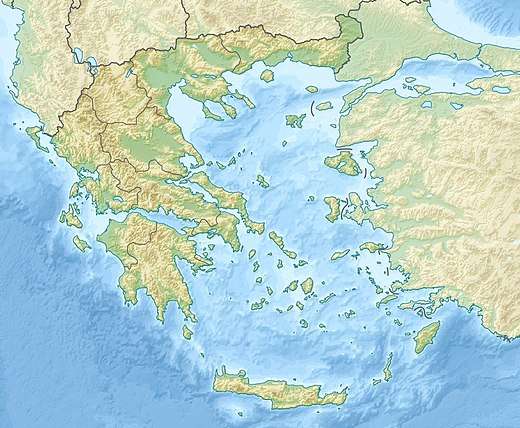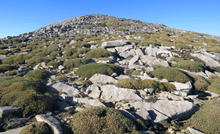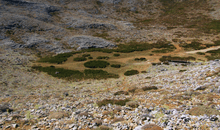Psiloritis Natural Park
Psiloritis Natural Park (Greek Φυσικό Πάρκο Ψηλορείτη) is a geopark located in the island of Crete, in southern Greece.
| Psiloritis Natural Park | |
|---|---|
| (in Greek) Φυσικό Πάρκο Ψηλορείτη | |
.png) Traditional shepherds' hut nerby Livadia | |
 | |
| Location | Crete, Greece |
| Area | 1,159[1] km2 (447 sq mi) |
| Established | 2001[2] |
| Governing body | AKOMM – Psiloritis development agency s.a, organization of local government |
| www.psiloritisgeopark.gr | |
History
Since 2001 the park is member of the European Geoparks Network[3] and UNESCO Global Geoparks Network [4]. It is a local authorities' initiative, managed by the geopark's management committee under the AKOMM Psiloritis S.A.[5]. The Natural History Museum of the University of Crete is the scientific advisor of the park[6].
Features

Psiloritis Natural Park extends on the Psiloritis mountain and its northern foothills till the Cretan Sea. It has an area of 1159 km2[1]. Administratively the park is split into the Prefectures of Rethymno and Heraklion. The headquarters of the park are located at the municipality of Anogeia[7]
The park aims to conserve natural and cultural heritage of Psiloritis area through promotional and educational activities, as well as sustainable development initiatives like geotourism, ecotourism and agrotourism. Due to its geological features many universities across the world organise field trips for their students to visit the park.[8] Among the geological protected features of the park there are many caves, included the Idaean Cave.[9]. The caves, as well as other relevant features of the park, are connected to the Karstic nature of the Mount Ida massif.[1]
References
- AA.VV. (2007). Géochronique (in French). Bureau de recherches géologiques et minières. p. 14. Retrieved 2020-04-01.
- "Φυσικό Πάρκο Ψηλορείτη - Παγκόσμιο Γεωπάρκο UNESCO" (in Greek). psiloritisgeopark.gr. Retrieved 2020-03-30.
- "Meet our Geoparks". European Geopark Network. Retrieved 2020-03-30.
- "Psiloritis Natural Park - UNESCO Global Geopark". psiloritisgeopark.gr. Retrieved 2020-03-30.
- "Psiloritis Natural Park". AKOMM. Retrieved 2020-03-30.
- "Natural History Museum of Crete (NHMC)". Sitia Nature Park. Retrieved 2020-03-30.
- "Εnvironmental Education Center of Anogia". psiloritisgeopark.gr. 2020-03-24. Retrieved 2020-03-30.
- M. A. Parkes (2004). Natural and Cultural Landscapes: The Geological Foundation - Proceedings of a Conference, 9-11 September 2002, Dublin Castle, Ireland. Royal Irish Academy. p. 293. Retrieved 2020-03-29.
- Filippo Ceragioli (2020-01-16). "Psiloritis, il geoparco del giovane Zeus". Piemonte Parchi (in Italian). Retrieved 2020-03-30.
External links
![]()
